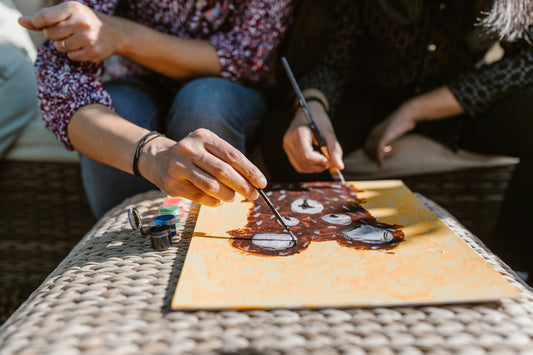Acrylic paint is a favorite among artists due to its versatility, quick-drying nature, and vibrant colors. However, these same quick-drying qualities can sometimes lead to a frustrating problem: dried up paint. Whether it’s leftover paint in a palette or a tube that wasn’t sealed properly, dried acrylic paint might seem like a lost cause. The good news? You don’t always have to throw it away! This guide will walk you through how to rehydrate dried acrylic paint so you can revive your colors and continue creating.
Why Does Acrylic Paint Dry Out?
Acrylic paint is water-based, which means it dries as the water in it evaporates. This can happen if the paint is left out in the open for too long, if it’s not sealed properly, or if the storage conditions are too dry. Over time, the paint can harden, losing its smooth and workable texture.
Luckily, with a few simple tricks, you can often bring dried acrylic paint back to life!
How to Rehydrate Dried Acrylic Paint in a Palette

If you’ve left paint in your palette and it has dried, don’t worry it’s usually one of the easier types of dried paint to rehydrate. Here’s what you can do:
Step 1: Add Water
Start by adding a few drops of water directly to the dried acrylic paint. Use a clean dropper, spray bottle, or even a brush to gently add moisture. Be careful not to add too much at once; you can always add more water later.
Step 2: Mix Gently
Using a palette knife or the back of a paintbrush, gently mix the water into the paint. Try to break up the dried clumps and mix the paint until it regains its original texture. This process may take some time, so be patient and keep working the paint with small amounts of water.
Step 3: Test the Paint’s Consistency
Once you’ve mixed in enough water, test the paint’s consistency by applying it to a piece of scrap paper or canvas. If it’s too thick, continue adding water in small increments. If the paint is too watery, let it sit for a few minutes to give the water time to absorb.
How to Rehydrate Dried Acrylic Paint in a Tub, Tube or Jar

Any paint by numbers enthusiast knows how frustrating it is when you don't close a tub of paint properly and it dries out. When acrylic paint dries inside a tub, tube or jar, it can be a bit trickier to rehydrate. However, you can still try to revive it with the following steps:
Step 1: Add Water to the Tub, Tube or Jar
If the paint has started to harden inside a tub, tube or jar, add a small amount of water directly into the container. In the case of a tube, you can use a dropper to introduce water slowly. For jars and tubs, carefully add water using a small spoon or syringe to control the amount and ensure even distribution.
Step 2: Shake or Stir the Paint
Once you’ve added water, seal the tub, tube or jar tightly and shake it vigorously. This will help distribute the water evenly throughout the paint. If the paint is in a jar, use a palette knife or stick to stir and break up the dried chunks while working the water into the mixture.
Step 3: Let It Sit
After shaking or stirring, let the paint sit for a few hours to allow the water to be absorbed by the dried paint. In some cases, you may need to repeat the process of adding water and stirring to fully revive the paint.
Step 4: Test the Paint
Before using the paint, test it on a small surface to ensure it has returned to its normal texture and consistency. If it’s still too thick or grainy, you may need to repeat the rehydration process or mix in a paint medium to help restore its smoothness.
Using Acrylic Mediums to Rehydrate Dried Paint
While water is often the easiest and most accessible way to rehydrate dried acrylic paint, there are also acrylic mediums designed specifically for this purpose. These mediums can help restore the paint's texture without thinning it out too much.
1. Acrylic Retarder
An acrylic retarder is a medium designed to slow the drying time of acrylic paint. While it won’t rehydrate fully dried paint, it can help revive paint that is starting to thicken or dry out. Simply mix a small amount of retarder into the paint to restore its workability.
2. Acrylic Flow Improver
Acrylic flow improvers are mediums that help paint flow more smoothly, and they can be useful for rehydrating dried acrylic paint. Mix a few drops of flow improver into the paint to restore its smooth consistency without watering it down too much.
3. Acrylic Gel Medium
Acrylic gel medium can be added to dried paint to help restore its body and thickness. This is especially useful if rehydrating the paint with water has made it too runny. Mix in a small amount of gel medium to regain the desired texture.
How to Prevent Acrylic Paint from Drying Out in the Future
Prevention is always better than cure. Here are a few tips to prevent your acrylic paint from drying out in the future:
- Use an Airtight Seal: Always make sure your paint tubes and jars are tightly sealed after each use. If the lid is loose, the air will cause the paint to dry out.
- Store Paint Properly: Store your acrylic paints in a cool, dry place, away from direct sunlight. High temperatures can cause paint to dry faster, even when it’s sealed.
- Use a Stay-Wet Palette: A stay-wet palette keeps your paint moist while you’re working by trapping moisture in the palette. This is especially useful for artists who work on larger projects that take time to complete.
- Mist the Paint with Water: While working, keep a spray bottle of water nearby and mist your palette occasionally to prevent the paint from drying out too quickly.




